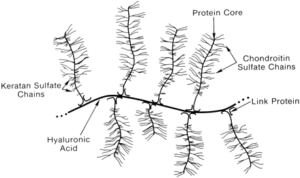No products in the cart.
Cartilage, tendons, ligaments & skin in brief
The tissues of cartilage, tendons, ligaments and skin have strong common features. In scientific language they are part of the “extra cellular matrix” and in everyday life they are known as “connective tissue”. The building blocks of connective tissue are the same for cartilage, tendons, ligaments and skin (especially in the subcutaneous layers, the hypodermis): collagen fibres, elastin fibres and proteoglycans.
Structural proteins
Structural proteins determine the shape and give strength to our tissues. Elastin and collagen are examples of structural proteins. Collagen is found in humans and animals, but not in plants. Collagen fibres are very resistant to traction and hardly stretch. It is the most widespread protein in the human body and is made up of amino acids assembled in a precise order, and those that are particularly represented are glycine, proline, hydroxyproline and hydroxylysine.
There are several types of collagen which have slightly different structures. Types 1 and 3 are particularly located in the skin, tendons, ligaments, bones and teeth. Type 2 collagen is largely located in the cartilage of the joints.
Collagen is made up of three long protein chains that link together through disulphide bridges and hydrogen bonds. Together, these three long protein chains form a triple helix collagen (see drawing). Several triple helices of collagen form a fibril and several fibrils then form a collagen fibre.

Illustration: Collagen triple-helix
Amino acids
Amino acids are the smallest building blocks of proteins, such as collagen or elastin. A total of twenty types of amino acids are known today, which are found in all proteins in the human body. Of these twenty amino acids, eight are essential, i.e. the human body does not create them (isoleucine, leucine, lysine, methionine, phenylalanine, threonine, tryptophan, valine). When an essential amino acid is only available in insufficient quantities, the other amino acids cannot be used for the creation of new proteins and are transformed into fat and sugar. This is why the human body requires a sufficient amount of essential amino acids from the regular diet.
Proteoglycans

Proteoglycans are another component of connective tissue, like cartilage. Proteoglycans have a great capacity to bind water molecules. They give the connective tissue its typical gel-like consistency and enable it to feed the surrounding tissue and transport molecules to the cells. Proteoglycans are located between collagen and elastin fibres. The shape of the proteoglycans can be imagined as the trunk of a fir tree: the trunk is made up of hyaluronic acid and the branches are made up of chondroitin sulphates, dermatan and keratan (see illustration). Glucosamine is the precursor of these proteoglycans.
Illustration: Proteoglycan
Disclaimer of liability:
The information published on www.swiss-alp-health.ch does not claim to be complete and is not a substitute for individual medical advice or treatment. It cannot be used as an independent diagnosis or to select, apply, modify or discontinue treatment of a disease. In case of health problems, it is recommended to consult a doctor. Access to www.swiss-alp-health.ch and its contents is at the user’s own risk.

